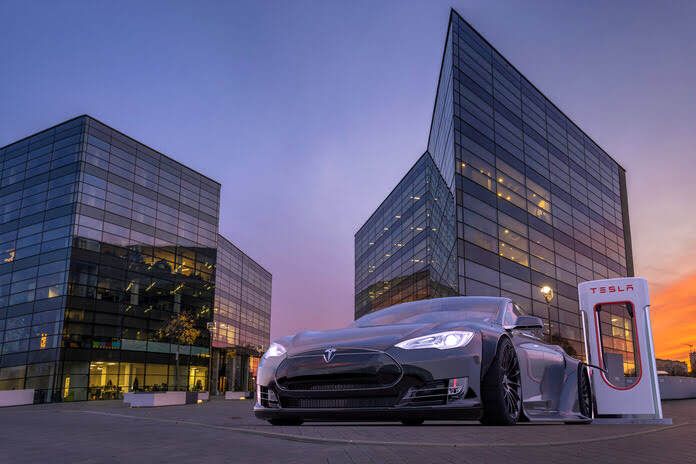Tesla Stock (NASDAQ:TSLA)
Following General Motors’ announcement that its electric vehicles would be able to charge using Tesla’s charging network, Tesla stock (NASDAQ:TSLA) surged higher on Friday. That information came after Ford made a comparable announcement just two weeks earlier.
As of the time of writing, the company’s stock had risen by about $12 per share, or 5%, for the day.
For the time being, Tesla chargers cannot be used with Ford or GM electric vehicle drivers’ vehicles without special adapters. Later, the automakers intend to create new electric vehicles that can be charged using chargers modeled after Teslas without an adapter.
Concerns that Elon Musk’s company will monopolize the industry are driving charging stocks like ChargePoint and EVgo lower as a result of Tesla’s agreements to open its EV supercharging network to Ford Motor (NYSE:F) and General Motors (NYSE:GM). However, if it makes drivers more at ease with electric vehicles, the standardization of charging could be good news.
Lack of EV Charging Infrastructure
With roughly 17,000 active ports, Tesla already has the largest network of fast EV chargers in America. Tesla will also become the standard for charging thanks to the announcements from GM and Ford. That is harming charging players that are publicly traded. On Friday morning, shares of EVgo (NASDAQ:EVGO) and ChargePoint (NYSE:CHPT) were down more than 13% and 14%, respectively. The Nasdaq Composite and S&P 500 both saw gains of 0.2% and 0.4%, respectively.
That seems like a hasty response. First off, there is a severe lack of EV charging infrastructure in the United States. By the end of 2022, there were about 50 electric vehicles (EVs) in use nationwide for every fast-charging plug. According to calculations by Bloomberg BNEF and Barron’s, that number is closer to 12 in China. There is space for many participants.
The most likely explanation for the decline in shares is the charging plug. GM also declared it would adopt Tesla’s charging plug, which is based on Tesla’s North American Charging Standard, or NACS, along with the news that its electric vehicle drivers will have access to Tesla’s charging network.
In North America, non-Tesla electric vehicles use a combined charging system, or CCS, plug. So, CCS is no more, Long live NACS? Not really, and even if it were, investors would be better off asking, Who cares?
Charging cables are not analogous to Betamax and VHS videotapes, nor are they comparable to earlier standards-related patent disputes between Qualcomm and Apple. The predicament is more comparable to what users of Samsung’s C-port connectors and Apple lightning cables experience. Perhaps engineers would disagree. Who cares? The engineers are the answer to that question.
Hardware for cars is more substantial and large than that for phones. A car receives a lot more power from EV charging wires than a phone does from a 120-volt wall outlet. No one really cares if the iPhone charger is warm. Another issue is an EV charging cord that is warm.
Additionally, phones are unable to recharge the grid on a hot day or power your home during a blackout. Most EVs should be able to complete both tasks in one day. For that, bidirectional charging standards will also be needed. More plug technology there.
The cost of switching and retrofitting is real. “This divergence in standards is repeating itself before our eyes with EV charging,” says Scott Case, CEO of EV research and resource provider Recurrent. “If you’ve ever wondered why you have to bring a plug adapter when you travel to Europe,” He asserted that the CCS systems will need to change.
Retrofitting and consolidation of the industry around a standard, however, need not be an existential threat to current players. Furthermore, Tesla doesn’t seem to want to be the EV charging industry’s gatekeeper, ‘charging’ a fee for everyone to use its technology.
A request for comment was not answered by the business, but Tesla opened up its charging standard in 2022. By granting other automakers access to its EV chargers, Tesla is able to use federal funding for the construction of charging infrastructure. There is every indication that Tesla intends to cooperate when it comes to charging.
A standard plug should eventually simplify things. A single organization that sets standards would be helpful to the sector. Remember that the placement of charging ports and the length of charging cords are not standard. In order for a cord to reach, it is common to see an electric vehicle parked perpendicular to a charger in a mall.
Do not forget that Tesla vehicles can and do charge at other stations even though it owns the largest charging network in the United States. Adapters are available.
“This is obviously big news, and EVgo continues to be a big proponent of Electric For All and welcomes all EV drivers on our network,” says Jonathan Levy, EVgo’s chief executive officer. “We hope that NACS will be published in a way that suppliers across the industry will have access to deliver more charging options for EV drivers in terms of charging standards moving forward.”
The thing that investors should look out for is that. Simply ensure that manufacturers of charging equipment have all the specifications and technology necessary to produce what is required so that operators like EVgo won’t experience difficulties or incur additional costs.
A GM spokesperson says, “In fact, there are a number of standards bodies, and we encourage them to think about partnering with the companies making the switch [to NACS].” In the end, it’s about giving consumers easier access to a common standard.
GM enjoys NACS. The Tesla plug may be on its way out in North America, but Tesla vehicles are still used in Europe with CCS connectors. Oh, the connector is different in China. EVs remain the newest technology. It requires time.
Investors should focus more on profits and less on standards. When the idea of opening up its network was first proposed about a year ago, Goldman Sachs analysts estimated $1 billion to $3 billion in annual charging revenue for Tesla.
Investors in EV charging stocks should be more concerned about the number of EVs on American roads than they should be about Tesla’s rivals. The GM-Ford-Tesla access deals are designed to raise that figure. It’s likely that more businesses will start utilizing Tesla chargers.
Many gas station businesses have been able to survive. Innovation in fuel dispenser design was the reason none survived. In the United States, there are two head designs for gasoline dispensers (plus one for diesel). Additionally, the small arrow next to the fuel pump on your fuel gauge indicates which side of the tank your access port is on. Simple, universal standards are beneficial to everyone.
Featured Image: Unsplash















